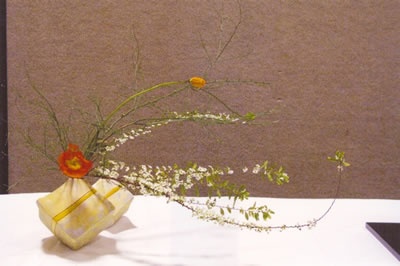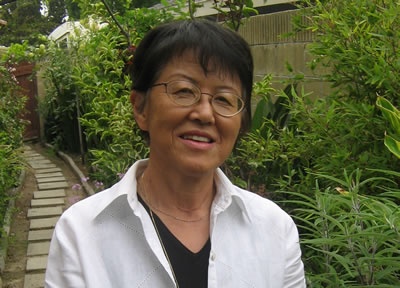Avoiding fixation to my own teaching methods: Gathering interest by attending lectures
The Iemoto of Ikenob? is on its 45th generation, now with over 500 years of history. Perhaps becoming an instructor is something that is passed on from our parents’ generation. Arimura-san, who originally began instruction in the southwestern district and now teaches around Costa Mesa in Orange County, also has a mother in Kagoshima who was an Ikenob? instructor.
“Since junior high school, I was learning the basics directly from my mother. But of course, when you learn from someone in your own family, they tend to be too nice to you. I ended up receiving some strict instruction for flower arrangements and tea ceremonies from my mother’s instructor.”
Thereafter, she moved from Kagoshima to Los Angeles for marriage. After putting ikebana on hold for a while, what inspired Arimura-san to return to it again was an ikebana class at the Japanese school adjacent to her home. “You can see the ikebana class through the windows, you see. So then I met Shinbashi Wako-sensei, and voluntarily became committed to Ikenob?.”
She joined the American Ikenob? in 1963, and entered instructorship in 1977. Since then, she has taught several students with various ethnic backgrounds. We asked Arimura-san if she had any tips on how to nurture the growth of her students, regardless of their ethnicity.
“Two to three times a year, a lecturer from Ikenob? is dispatched to the US to hold a workshop. I strongly urge any student who shows interest to attend the workshops. It’s because they’ll be able to learn something other than what they learn from me as their direct instructor. By learning something different from another instructor, often times the students find a renewed interest (in ikebana). In addition, with this increased interest, some of them begin to search for their own material, whereas usually I would provide them. Some will start to grow their own plants and flowers in their yard, or begin to make their way to the flower market. I notice that a person who does that will actively become involved and experience wonderful growth.”
Depending on the instructor, some are strongly against their students pursuing styles outside of their philosophy. However, Arimura-san will say that, “Personally, I believe I shouldn’t fixate myself to just my own style of teaching. By doing so, you can become close-minded and end up putting a limit on your potential.” She maintains a humble heart, and above all, remains flexible.
Studies in Kyoto: Touching upon the essence of ikebana
In Kyoto, where Ikenob? headquarters is located, a training seminar is held once every four years. Most of the participants are Americans. John Kenneth is the resident translator at the headquarters, and thanks to his perfect translation of ikebana terminology, he has become a necessary fixture for headquarters to accommodate the international participants.
Arimura-san’s American students have attended this seminar several times. Arimura-san recommends the seminar because she says there is a limit to what you can learn from just one instructor, but moreover, by experiencing Kyoto—the birthplace of ikebana—perhaps they are able to dig deeper and learn about the essence of ikebana.
As Arimura-san had hoped, the students who participated in the seminar “come away even more enchanted by the flowers, and looking forward to the next seminar; they work with a renewed passion for ikebana.” Not only do these events take place in Kyoto, but they are periodically held for anniversary events at different branches all over the world. Arimura-san had just returned from an anniversary event in Anchorage, Alaska, in July of 2008.
“There were about 150 attendees at the event, and the Iemoto was also present with a group of about 30 members from Japan. The Alaskan members were almost all Caucasian. The head of the Alaskan branch is a very enthusiastic person whom I always see when I go to Japan.”
In addition to its unique artistic beauty, the keyword that helps Japanese culture permeate into different regions of the world must be how “enthusiastically” it is presented.
Enthusiastic international students leading the way for community recruitment
Among the current students, there is a 16 year old whom Arimura-san refers to as “the Rising Star.” She is the grand-daughter of one of Arimura-san’s students, and perhaps in part because her parents own and run a nursery, she has been showing brilliant flashes of talent.
Also, there is a Vietnamese student who has been learning for over 20 years, who works as a stylist. Showing great skill with her hands, she has also been very enthusiastic, recruiting four to five friends at once to join the class. “She hasn’t missed a single workshop,” says Arimura-san. “During an interview by the Orange County Register (an Orange County newspaper) for an ikebana-themed article, I heard her saying, ‘Even when I wake up in the middle of the night, I’ll cut some flowers in my garden and arrange them. It helps me gain some inner peace.’ She definitely understands the ‘heart’ of the flower. I’m hoping that she will be able to open up the doors of ikebana to the Vietnamese community.”
So for someone who continues to instruct students in their 70’s, teenagers, American housewives, and Vietnamese stylists, what does ikebana mean to Arimura-san?
“It is life itself. I was just 50 years old when my husband passed away. During that time, arranging the flowers, teaching ikebana—that is was supported me through it all. It’s not that flowers pave the way for my income or anything, but without flowers, I wouldn’t be able to live. Many people seem to wonder what they would end up doing after retirement, but there was no such worry for me. My mother in Kagoshima, who first introduced me to ikebana, lived until she was 95—and as we sometimes hear that ‘greens are good for your eyes,’ she never had problems with her vision for all those years.”
As mentioned in Shiba-san’s article, there isn’t much extravagance in Ikenob? that would catch the eye by surprise. However, the admiration and affection for the flowers and plants—in other words, the “heart of the flower,” is truly reflected in its arrangements. From Shiba-san and Arimura-san, I was touched by a strong feeling that ikebana is more than just an art. For them, to arrange flowers (ikeru) is to live (ikiru).
Profile: Moved from Kagoshima to Los Angeles in 1950 for marriage. Enrolled at Ikenob? Los Angeles District in 1963, and became an instructor in ‘77. In an Orange County event which President George Bush presided over, her works represented ikebana for Japan. Currently instructs classes in Costa Mesa and at the Orange County Buddhist Church.
© 2008 Keiko Fukuda









